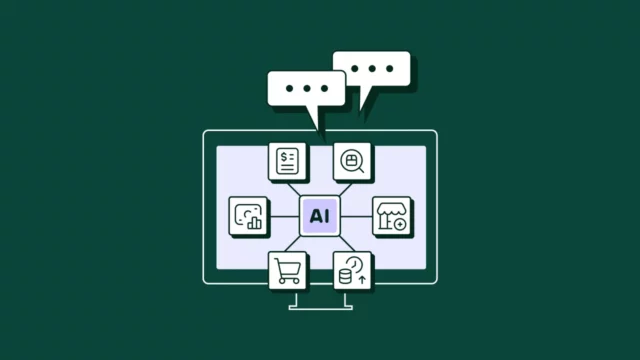How To Pick Procure-to-Pay Software (and 5 Tools to Consider)

How To Pick Procure-to-Pay Software (and 5 Tools to Consider)
Better systems are the key to better results, especially when your organization is on a growth track. A robust procure-to-pay (P2P) system is one of the most effective ways to streamline the procurement process while maintaining full visibility and control over indirect procurement spending.
Still, simply having a system in place isn't enough. To truly support growth, you need to optimize your procurement and purchasing processes with the most current technology, including well-designed AI procurement tools. But what does an effective procure-to-pay process look like? And can procurement automation help you keep spending under control as you grow?
To answer these questions, we’ll take a detailed look at what goes into a successful purchasing workflow. We’ll also cover some best practices for tightening up the process and show you how automation can help keep everything running smoothly as you scale.
Join us for an upcoming live conversation: register for ChatP2P: AI & the Back Office today
What is procure-to-pay software?
Procure-to-pay software is a digital tool for identifying, requesting, and paying for products. It focuses on the transactional aspects of the procurement function, meaning activities like strategic sourcing, lifecycle evaluations, vendor off/onboarding, and supply chain management fall outside its scope.
How does procure-to-pay automation software work?
Procurement automation software creates centralized, automated workflows for everything from item selection to invoice payment. On the front end, it simplifies the purchasing process for buyers by centralizing supply orders within a curated and approved catalog.
On the back end, it automates many of the manual, repetitive processes that slow down procurement teams. It automatically routes purchases through approval workflows. Then, once the orders are delivered, AI and machine learning kick in to process the invoices, ensuring they are correctly routed, reconciled, and paid—all without employee input.
Why procure-to-pay software is the best tool for modern ops
Procurement software helps organizations manage procurement and purchasing processes with less manual effort. This is especially important as companies grow and their order volume and operational complexities increase.
Procurement teams enjoy the following benefits when they implement a fully-featured P2P solution:
Automation: When teams handle procurement by hand, workflows slow down, errors and issues increase, and the cost to process transactions climbs dramatically. Procurement automation reduces the burden on accounts payable and procurement team members at a time when procurement workloads are increasing by over 10 percent.
Accuracy: Traditional methods of manual data entry, invoice approval, and payment reconciliation result in errors, excess time spent researching issues, unnecessary fees, and decreased vendor confidence. Automation ensures accurate and timely transactions.
Scalability: P2P software solutions scale with the number of suppliers and transactions. Instead of manual data entry and invoice management, software automation streamlines these tasks while also allowing administrators to set spending rules by user, department, category, or location.
AI enhancement: The AI and machine learning functions of P2P software help teams monitor their end-to-end procure-to-pay process in real time via dashboards or reporting. This allows them to make proactive rather than reactive changes. Top-performing platforms like Order.co use AI to power a sourcing algorithm that learns your company’s needs and refines the user experience based on predictive analytics.
How to choose procure-to-pay software
Advanced features and usability are the biggest selling points for procure-to-pay technology. When considering software options, look for tools that meet the following qualifications for functionality, user experience, and reporting:
- AI-enhanced functionality: Generative AI further enhances many of the features that make procurement software a sound investment. AI-powered platforms like Order.co make getting the best products at the best pricing far easier. They enable highly contextual search, support for streamlining logistics, vendor management features for taking advantage of contractual discounts, and predictive analytics for planning future spend.
- Automated invoice processing and matching: Three-way matching is a great start, but look for e-procurement options that create additional features for verifying and pairing invoices to procurement activities.
- Streamlined approval processes: Purchasing through the traditional procurement process requires involvement from various departments and leaders. Automation simplifies approvals, making it easier for everyone to see, research, and approve purchases.
- Reporting capabilities: Dashboards and easy-to-customize reporting views simplify visualization of key metrics, increasing understanding of the spending narrative.
- Integration potential: Every system becomes more valuable when it communicates with software tools already at work. A strong P2P cycle system offers seamless integrations with other enterprise resource planning (ERP) applications.
The top 5 procure-to-pay software solutions
1. Order.co
Order.co provides businesses of all sizes with straightforward yet powerful procure-to-pay features enhanced with proprietary AI models. The system offers ordering through a dynamic, curated catalog alongside next-level features like AI product substitution, role-based permissions, extensive reporting features, vendor-agnostic carts and orders, capital advance financing, and complete transaction capture for catalog and off-catalog spend.
Pros:
- Vendor-agnostic purchasing using direct integrations, API connections, or assistance from an Order.co team member
- Financing options for up to $500,000 in capital advance spending with universal net terms for all purchases and an easy application process
- Curated catalogs with dynamic role and location management features to ensure all spend is within policy
- Product pricing and contract access similar to those of a group purchasing organization (GPO) without the limitations
Cons:
- Intended for direct and indirect spend management; doesn’t support RFP/bid processes for purchasing raw materials
- You cannot directly purchase software licenses through Order.co, but new off-catalog spend features let you pay for subscriptions with an intuitive virtual procurement card
- Occasional slowdowns in loading platform screens, although the development team works consistently and diligently to address issues and increase site speed
2. PRM360
PRM360 is a cloud-based procure-to-pay system that helps mid-market and larger companies automate ordering and procurement. Its unique online bidding system gives procurement teams real-time visibility into bidding and outcomes.
Pros:
- Intuitive and easy to use for fast onboarding and self-service
- Workflow creation and customizations are flexible and scalable
Cons:
- Highly complex orders can slow the system down
- Some notification features make getting up-to-date information difficult
- Doesn't offer simultaneous log-in for teams
3. Coupa Procurement
Coupa's digital procurement tool helps enterprises manage a range of purchasing activities, from RFP development to invoice payments. It provides guided buying and submission workflows for ease of use.
Pros:
- Fast and flexible; great for large companies looking for enterprise-level performance
- Users outside Finance can develop and submit purchase orders and purchase requests
- Integrates with other components of the Coupa financial management suite
Cons:
- Steep learning curve; requires a time investment
- Reporting functionality isn't especially flexible; workarounds help bridge the gap, but improvement is needed
- Not the best for smaller businesses due to complexity and price
4. SAP Ariba
This P2P component of the SAP suite delivers modular solutions for enterprise resource management. The cloud-based system helps organize the buying process, control budgets, and manage cash flow through guided spending.
Pros:
- Flexible and customizable; great for SAP-savvy teams
- Robust integrations unify data into a single source of truth
- Well suited to enterprise organizations that need a central, modular system
Cons:
- UI isn’t intuitive
- Customer service isn’t always responsive to user needs
- Geared toward enterprises over smaller company structures
5. JAGGAER
The world’s largest independent spend management company offers a P2P platform tailored to small and mid-sized businesses. It combines powerful functionality with flexibility and provides strong integration with other resource planning and finance systems.
Pros:
- Intuitive and easy to learn for users at all levels
- Centralized vendor information system shortens procurement cycle times
- Fully featured for businesses of all sizes
Cons:
- Slow update roadmap leaves room for bugs and usability issues
- Reporting tools would benefit from improvements
- PO development features are hard to use
3 Best practices for improving your procure-to-pay process
With a few highly impactful best practices, you can streamline your business processes, maximize outcomes, and improve purchasing and payment functions.
1. Build a standard approval process for every purchase
Outlining a formal process for requesting and purchasing goods balances an organization's need for oversight and compliance with the need to support staff without hindering their progress.
The process doesn’t have to be elaborate—it just needs to lay out the path to approval and set expectations for requestors. The most effective workflows are easy to implement, track, and repeat, strengthening the procure-to-pay cycle and ensuring continuous improvement.
2. Outline contract and departmental requirements
Each approving department likely has standard requirements for its purchase requisitions. These prerequisites are essential for establishing high-quality procurement processes that reduce risk.
Possible departmental approvers include:
- Internal department lead review to provide preliminary approval
- Legal review for specific terms or clauses to enforce adequate contract protections
- Security for the completion of a supplier questionnaire to determine potential risk
- Finance approval for the release of funds, especially for high-dollar or multi-year contracts
To ensure smooth approval workflows, document and outline these requirements and enforce them through a software solution.
3. Consider automation
As organizations grow, the purchasing process expands exponentially, incorporating contract management for dozens or hundreds of vendors. In a short time, a traditional procure-to-pay process can become backlogged and inefficient.
Rather than continuing to expand the headcount for these operations, consider implementing an AI tool to handle repetitive and manual tasks.
ROI: What to expect with a procure-to-pay solution
A standardized, repeatable procure-to-pay process can be an excellent value driver. Streamlined workflows reduce maverick spending, make the purchase process faster, improve order and supplier management, and increase stakeholder productivity and satisfaction.
A modern, AI-enhanced platform can improve ROI at every step:
- Needs identification: Software makes it easier to find the exact products you need, reducing search time and streamlining purchasing. AI tools learn from the process and improve future product searches based on contextual data from transactions.
- Purchase requisition: AI-enhanced platforms empower buyers to create orders quicker and easier using a curated catalog. Users can find what they need from any vendor, submit the order for approval, and monitor the progress of their requisition. Software helps avoid cumbersome email-based approvals, saving time and ensuring policy compliance.
- PO creation: The system populates POs with all necessary information for order processing and goods delivery, eliminating manual processes that require labor for creation and review.
- Vendor performance management: With all data and contract information in a centralized location, AI can easily review vendor performance for compliance, price competitiveness, and other parameters. The system can also ensure buyers purchase goods that fulfill contract requirements, such as a specific volume of goods that unlocks supplier discounts.
- Payments and capital management: AI-powered payment features automate payments and cash flow. AI ensures you pay every vendor invoice on time, taking advantage of payment discounts while maintaining cash optimization. Order.co enhances AP automation through a variable net terms system to get the most out of your working capital.
See what’s next for procure-to-pay
Generative AI enhances decision-making and operations across the procurement function. It enables a curated buying experience, improves forecasting accuracy, eliminates manual tasks (and even complex ones like referencing contracts), and drives more cost-effective strategic sourcing. AI also automates data analysis and rote processes, giving procurement teams time to focus on strategic activities instead.
With Order.co's AI-powered procurement solution, you can:
- Automatically ensure budget compliance, purchase policy adherence, and optimized vendor selection
- Streamline supply chain management across multiple locations
- Reduce cost per invoice and associated invoice exception rates
- Stabilize cash flow by consolidating invoices and payments
- Surface procurement savings opportunities to improve the bottom line
- Gain real-time, line-level visibility into buying data for greater business spend efficiency
Learn how AI is reshaping the way modern orgs manage procurement, spend visibility, and reconciliation. Get a demo of Order.co today.
Get started
Schedule a demo to see how Order.co can simplify buying for your business.
"*" indicates required fields


![7 Benefits to Building a Solid Procurement Strategy & How To Do It [2023]](https://www.order.co/wp-content/uploads/2023/04/iStock-1188425195-640x360.webp)
